Finance Case Study: Restructuring Distressed Debt Portfolios Analysis
VerifiedAdded on 2019/09/26
|9
|1261
|396
Case Study
AI Summary
This case study focuses on the restructuring of distressed debt portfolios, exploring the challenges and opportunities in managing such assets. The analysis investigates the merits of restructuring, highlighting the benefits for investors, lenders, and borrowers through Pareto improvement. The author proposes a binomial tree model to overcome limitations in previous studies, addressing issues related to collateral value and default risk. The study examines risk and return analysis, considering factors like loan amount, equity stake, and coupon value. It also explores investor returns under different scenarios, including default probabilities and recovery rates. The methodology involves empirical study of various factors driving distressed-debt portfolio renegotiation, using a tree-based model for evaluating distressed debt with coupons and default risk. The conclusion emphasizes optimal restructuring strategies, portfolio construction, and the benefits of diversification. The case study discusses how investors, borrowers and lenders can handle distressed debt and manage the loan distribution.

Case study: 1
JULY 7, 2016
JULY 7, 2016
Paraphrase This Document
Need a fresh take? Get an instant paraphrase of this document with our AI Paraphraser

2 Case study: 1
Executive Summary
The assignment contains a case study of restructuring distressed debt portfolios. The case was deeply studied
and analyzed. A comprehensive summary, methodology and conclusion have been written down for the
case.
2
Executive Summary
The assignment contains a case study of restructuring distressed debt portfolios. The case was deeply studied
and analyzed. A comprehensive summary, methodology and conclusion have been written down for the
case.
2
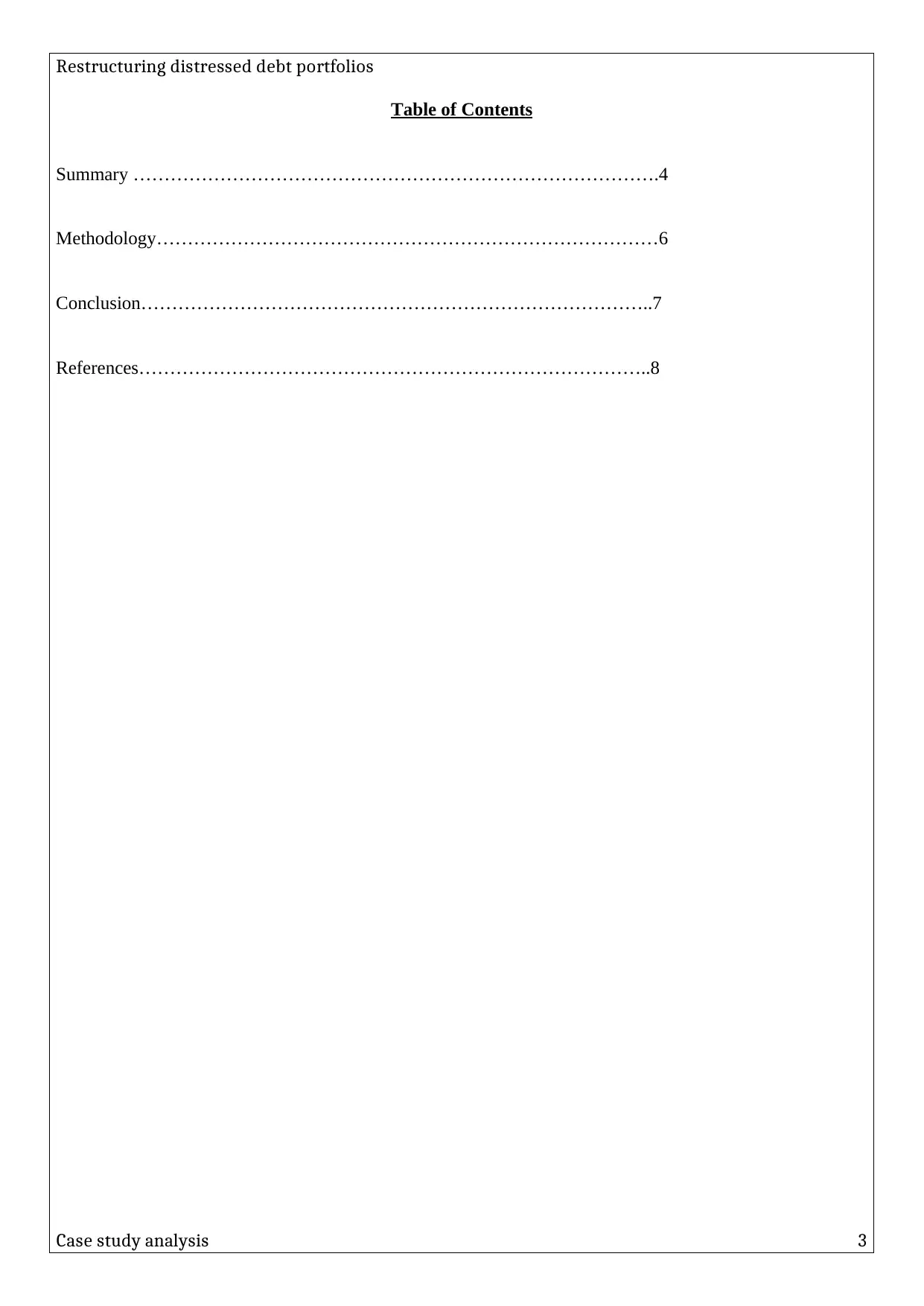
Restructuring distressed debt portfolios
Table of Contents
Summary ………………………………………………………………………….4
Methodology………………………………………………………………………6
Conclusion………………………………………………………………………..7
References………………………………………………………………………..8
Case study analysis 3
Table of Contents
Summary ………………………………………………………………………….4
Methodology………………………………………………………………………6
Conclusion………………………………………………………………………..7
References………………………………………………………………………..8
Case study analysis 3
⊘ This is a preview!⊘
Do you want full access?
Subscribe today to unlock all pages.

Trusted by 1+ million students worldwide
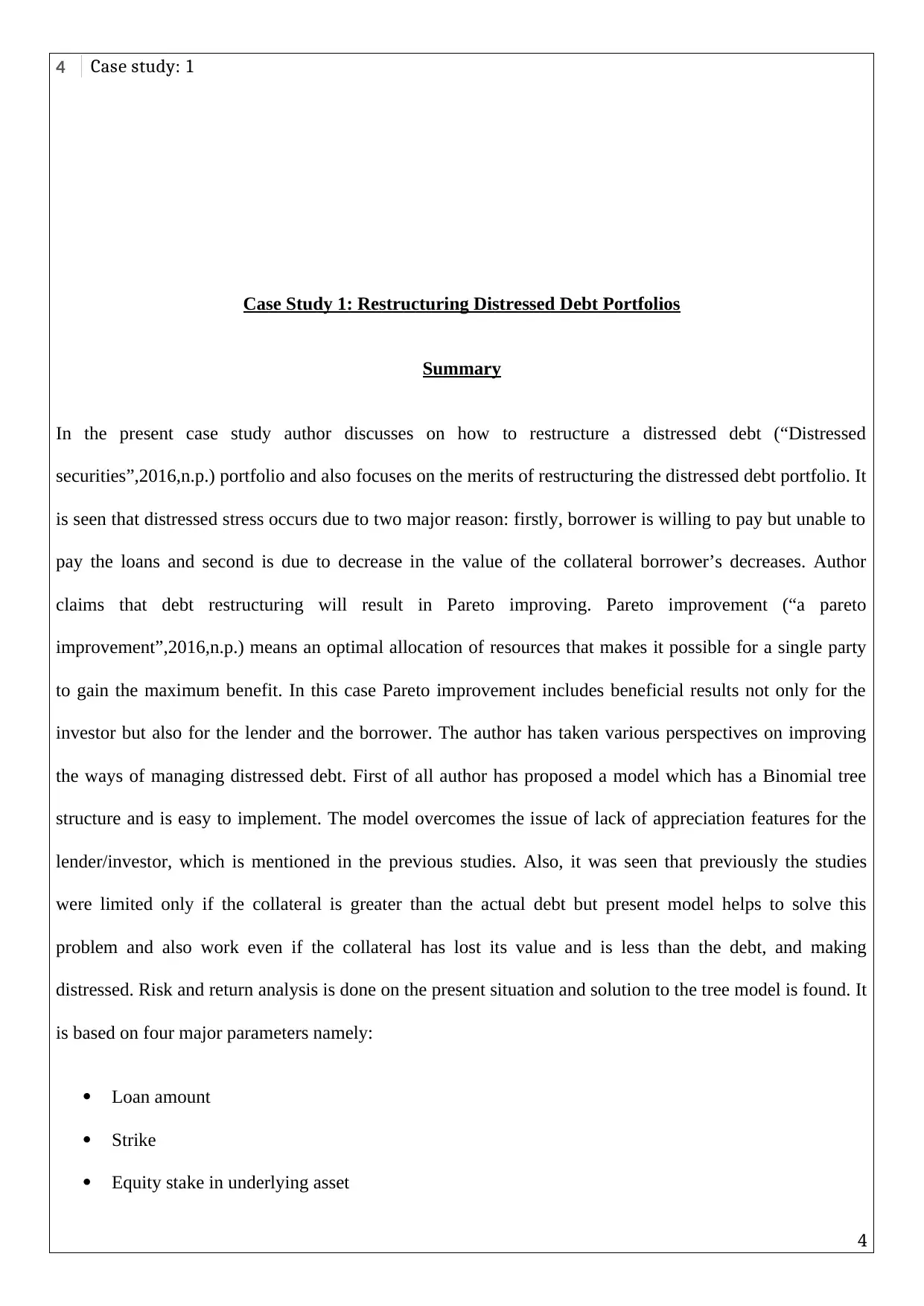
4 Case study: 1
Case Study 1: Restructuring Distressed Debt Portfolios
Summary
In the present case study author discusses on how to restructure a distressed debt (“Distressed
securities”,2016,n.p.) portfolio and also focuses on the merits of restructuring the distressed debt portfolio. It
is seen that distressed stress occurs due to two major reason: firstly, borrower is willing to pay but unable to
pay the loans and second is due to decrease in the value of the collateral borrower’s decreases. Author
claims that debt restructuring will result in Pareto improving. Pareto improvement (“a pareto
improvement”,2016,n.p.) means an optimal allocation of resources that makes it possible for a single party
to gain the maximum benefit. In this case Pareto improvement includes beneficial results not only for the
investor but also for the lender and the borrower. The author has taken various perspectives on improving
the ways of managing distressed debt. First of all author has proposed a model which has a Binomial tree
structure and is easy to implement. The model overcomes the issue of lack of appreciation features for the
lender/investor, which is mentioned in the previous studies. Also, it was seen that previously the studies
were limited only if the collateral is greater than the actual debt but present model helps to solve this
problem and also work even if the collateral has lost its value and is less than the debt, and making
distressed. Risk and return analysis is done on the present situation and solution to the tree model is found. It
is based on four major parameters namely:
Loan amount
Strike
Equity stake in underlying asset
4
Case Study 1: Restructuring Distressed Debt Portfolios
Summary
In the present case study author discusses on how to restructure a distressed debt (“Distressed
securities”,2016,n.p.) portfolio and also focuses on the merits of restructuring the distressed debt portfolio. It
is seen that distressed stress occurs due to two major reason: firstly, borrower is willing to pay but unable to
pay the loans and second is due to decrease in the value of the collateral borrower’s decreases. Author
claims that debt restructuring will result in Pareto improving. Pareto improvement (“a pareto
improvement”,2016,n.p.) means an optimal allocation of resources that makes it possible for a single party
to gain the maximum benefit. In this case Pareto improvement includes beneficial results not only for the
investor but also for the lender and the borrower. The author has taken various perspectives on improving
the ways of managing distressed debt. First of all author has proposed a model which has a Binomial tree
structure and is easy to implement. The model overcomes the issue of lack of appreciation features for the
lender/investor, which is mentioned in the previous studies. Also, it was seen that previously the studies
were limited only if the collateral is greater than the actual debt but present model helps to solve this
problem and also work even if the collateral has lost its value and is less than the debt, and making
distressed. Risk and return analysis is done on the present situation and solution to the tree model is found. It
is based on four major parameters namely:
Loan amount
Strike
Equity stake in underlying asset
4
Paraphrase This Document
Need a fresh take? Get an instant paraphrase of this document with our AI Paraphraser
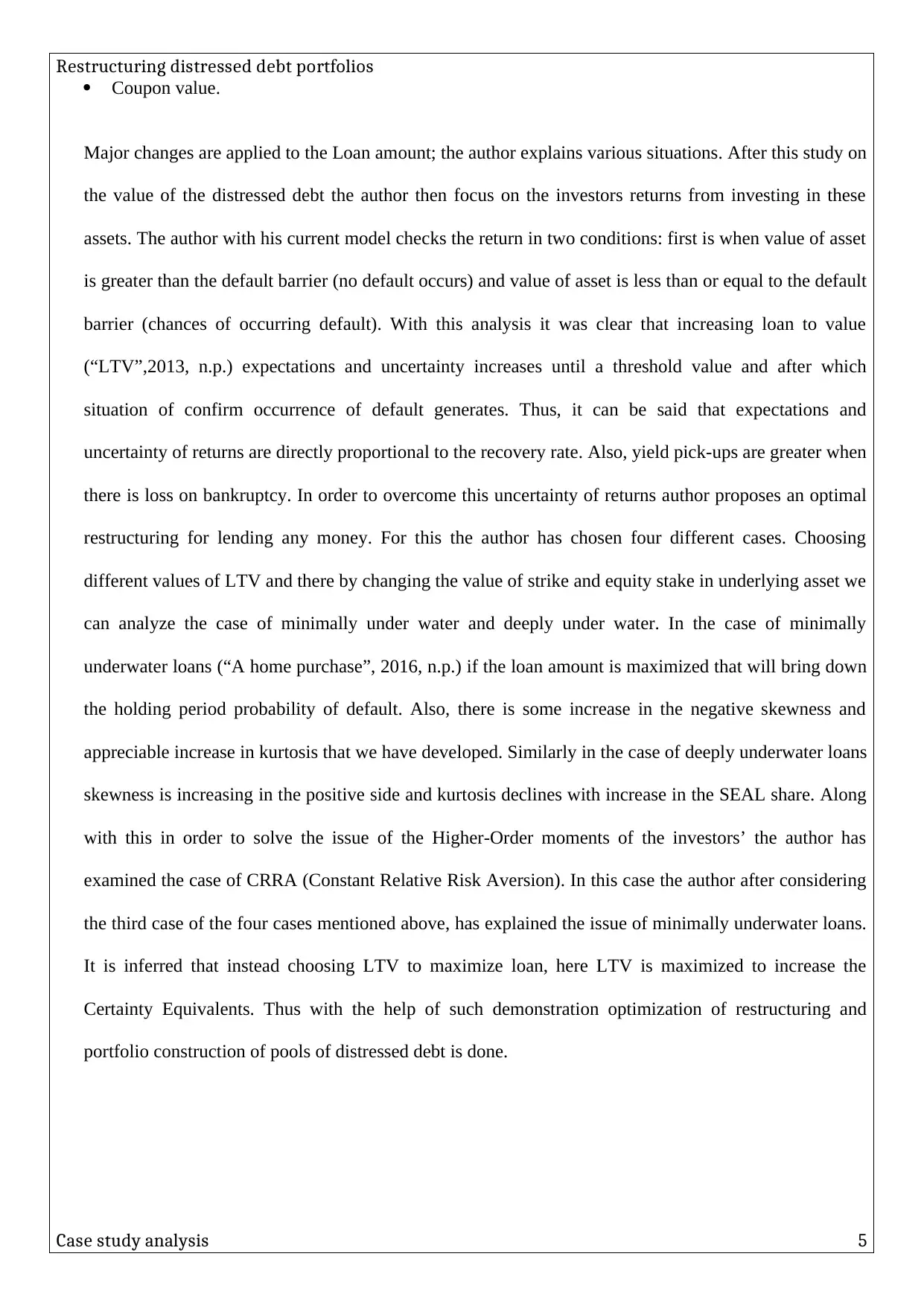
Restructuring distressed debt portfolios
Coupon value.
Major changes are applied to the Loan amount; the author explains various situations. After this study on
the value of the distressed debt the author then focus on the investors returns from investing in these
assets. The author with his current model checks the return in two conditions: first is when value of asset
is greater than the default barrier (no default occurs) and value of asset is less than or equal to the default
barrier (chances of occurring default). With this analysis it was clear that increasing loan to value
(“LTV”,2013, n.p.) expectations and uncertainty increases until a threshold value and after which
situation of confirm occurrence of default generates. Thus, it can be said that expectations and
uncertainty of returns are directly proportional to the recovery rate. Also, yield pick-ups are greater when
there is loss on bankruptcy. In order to overcome this uncertainty of returns author proposes an optimal
restructuring for lending any money. For this the author has chosen four different cases. Choosing
different values of LTV and there by changing the value of strike and equity stake in underlying asset we
can analyze the case of minimally under water and deeply under water. In the case of minimally
underwater loans (“A home purchase”, 2016, n.p.) if the loan amount is maximized that will bring down
the holding period probability of default. Also, there is some increase in the negative skewness and
appreciable increase in kurtosis that we have developed. Similarly in the case of deeply underwater loans
skewness is increasing in the positive side and kurtosis declines with increase in the SEAL share. Along
with this in order to solve the issue of the Higher-Order moments of the investors’ the author has
examined the case of CRRA (Constant Relative Risk Aversion). In this case the author after considering
the third case of the four cases mentioned above, has explained the issue of minimally underwater loans.
It is inferred that instead choosing LTV to maximize loan, here LTV is maximized to increase the
Certainty Equivalents. Thus with the help of such demonstration optimization of restructuring and
portfolio construction of pools of distressed debt is done.
Case study analysis 5
Coupon value.
Major changes are applied to the Loan amount; the author explains various situations. After this study on
the value of the distressed debt the author then focus on the investors returns from investing in these
assets. The author with his current model checks the return in two conditions: first is when value of asset
is greater than the default barrier (no default occurs) and value of asset is less than or equal to the default
barrier (chances of occurring default). With this analysis it was clear that increasing loan to value
(“LTV”,2013, n.p.) expectations and uncertainty increases until a threshold value and after which
situation of confirm occurrence of default generates. Thus, it can be said that expectations and
uncertainty of returns are directly proportional to the recovery rate. Also, yield pick-ups are greater when
there is loss on bankruptcy. In order to overcome this uncertainty of returns author proposes an optimal
restructuring for lending any money. For this the author has chosen four different cases. Choosing
different values of LTV and there by changing the value of strike and equity stake in underlying asset we
can analyze the case of minimally under water and deeply under water. In the case of minimally
underwater loans (“A home purchase”, 2016, n.p.) if the loan amount is maximized that will bring down
the holding period probability of default. Also, there is some increase in the negative skewness and
appreciable increase in kurtosis that we have developed. Similarly in the case of deeply underwater loans
skewness is increasing in the positive side and kurtosis declines with increase in the SEAL share. Along
with this in order to solve the issue of the Higher-Order moments of the investors’ the author has
examined the case of CRRA (Constant Relative Risk Aversion). In this case the author after considering
the third case of the four cases mentioned above, has explained the issue of minimally underwater loans.
It is inferred that instead choosing LTV to maximize loan, here LTV is maximized to increase the
Certainty Equivalents. Thus with the help of such demonstration optimization of restructuring and
portfolio construction of pools of distressed debt is done.
Case study analysis 5
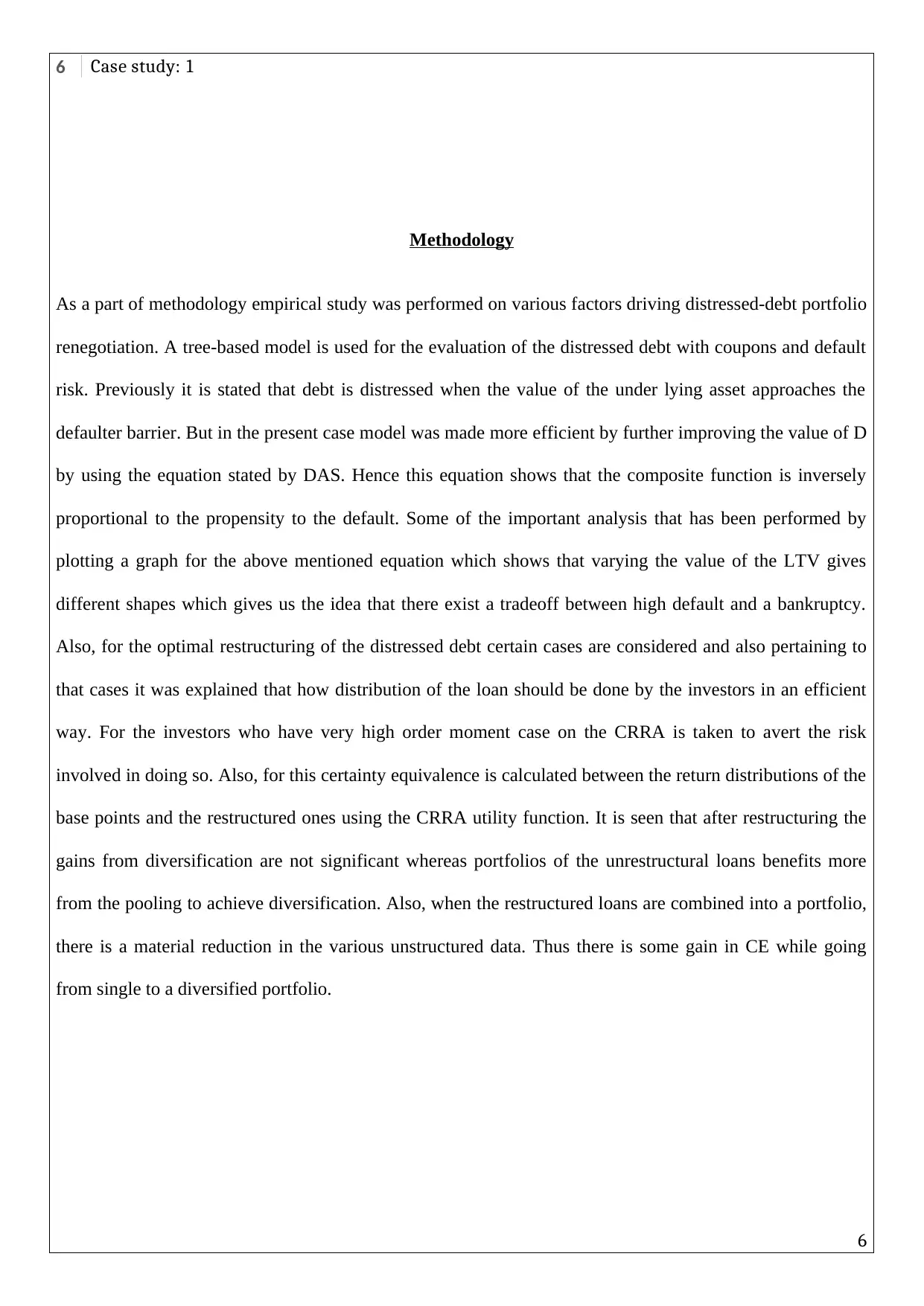
6 Case study: 1
Methodology
As a part of methodology empirical study was performed on various factors driving distressed-debt portfolio
renegotiation. A tree-based model is used for the evaluation of the distressed debt with coupons and default
risk. Previously it is stated that debt is distressed when the value of the under lying asset approaches the
defaulter barrier. But in the present case model was made more efficient by further improving the value of D
by using the equation stated by DAS. Hence this equation shows that the composite function is inversely
proportional to the propensity to the default. Some of the important analysis that has been performed by
plotting a graph for the above mentioned equation which shows that varying the value of the LTV gives
different shapes which gives us the idea that there exist a tradeoff between high default and a bankruptcy.
Also, for the optimal restructuring of the distressed debt certain cases are considered and also pertaining to
that cases it was explained that how distribution of the loan should be done by the investors in an efficient
way. For the investors who have very high order moment case on the CRRA is taken to avert the risk
involved in doing so. Also, for this certainty equivalence is calculated between the return distributions of the
base points and the restructured ones using the CRRA utility function. It is seen that after restructuring the
gains from diversification are not significant whereas portfolios of the unrestructural loans benefits more
from the pooling to achieve diversification. Also, when the restructured loans are combined into a portfolio,
there is a material reduction in the various unstructured data. Thus there is some gain in CE while going
from single to a diversified portfolio.
6
Methodology
As a part of methodology empirical study was performed on various factors driving distressed-debt portfolio
renegotiation. A tree-based model is used for the evaluation of the distressed debt with coupons and default
risk. Previously it is stated that debt is distressed when the value of the under lying asset approaches the
defaulter barrier. But in the present case model was made more efficient by further improving the value of D
by using the equation stated by DAS. Hence this equation shows that the composite function is inversely
proportional to the propensity to the default. Some of the important analysis that has been performed by
plotting a graph for the above mentioned equation which shows that varying the value of the LTV gives
different shapes which gives us the idea that there exist a tradeoff between high default and a bankruptcy.
Also, for the optimal restructuring of the distressed debt certain cases are considered and also pertaining to
that cases it was explained that how distribution of the loan should be done by the investors in an efficient
way. For the investors who have very high order moment case on the CRRA is taken to avert the risk
involved in doing so. Also, for this certainty equivalence is calculated between the return distributions of the
base points and the restructured ones using the CRRA utility function. It is seen that after restructuring the
gains from diversification are not significant whereas portfolios of the unrestructural loans benefits more
from the pooling to achieve diversification. Also, when the restructured loans are combined into a portfolio,
there is a material reduction in the various unstructured data. Thus there is some gain in CE while going
from single to a diversified portfolio.
6
⊘ This is a preview!⊘
Do you want full access?
Subscribe today to unlock all pages.

Trusted by 1+ million students worldwide
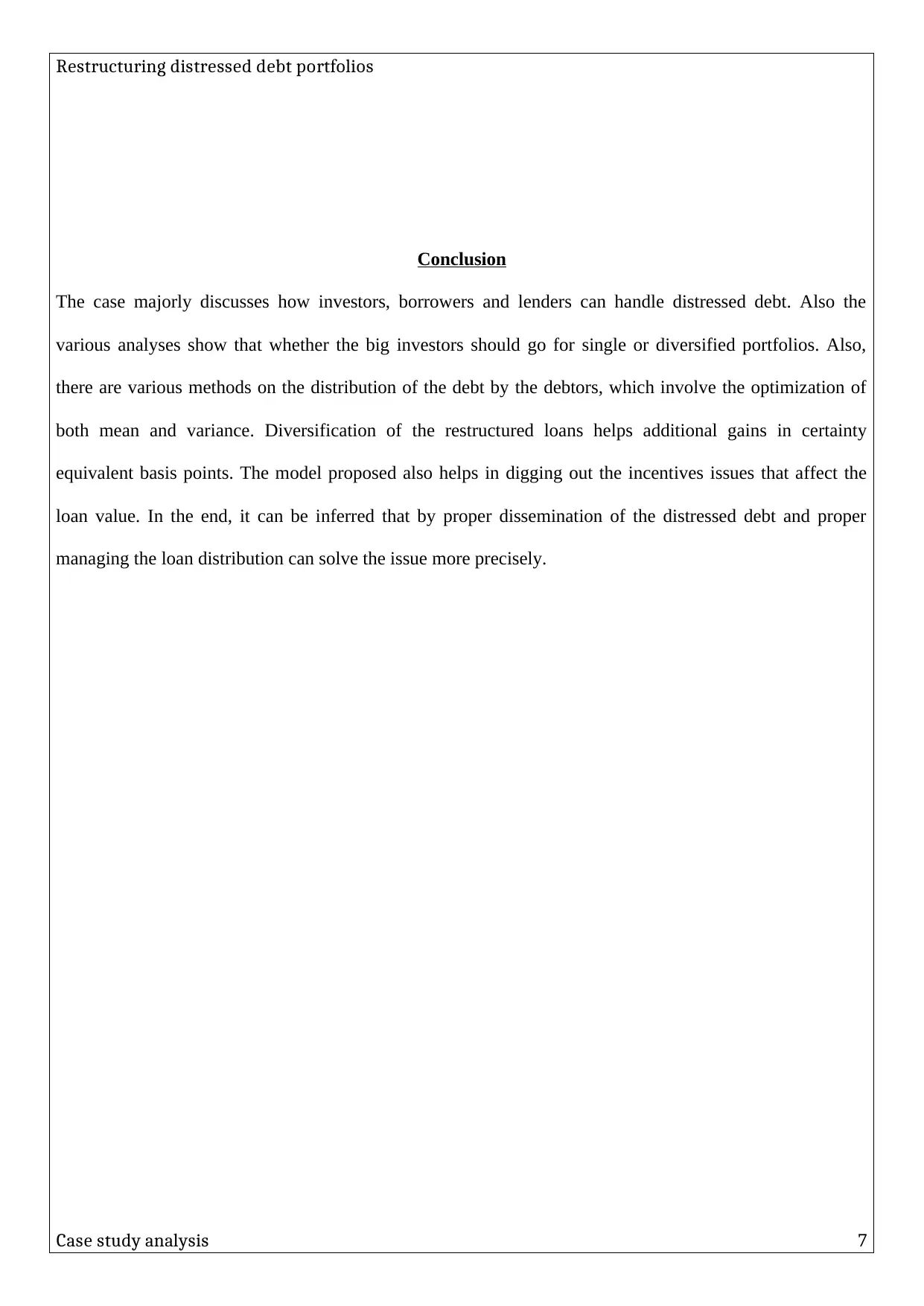
Restructuring distressed debt portfolios
Conclusion
The case majorly discusses how investors, borrowers and lenders can handle distressed debt. Also the
various analyses show that whether the big investors should go for single or diversified portfolios. Also,
there are various methods on the distribution of the debt by the debtors, which involve the optimization of
both mean and variance. Diversification of the restructured loans helps additional gains in certainty
equivalent basis points. The model proposed also helps in digging out the incentives issues that affect the
loan value. In the end, it can be inferred that by proper dissemination of the distressed debt and proper
managing the loan distribution can solve the issue more precisely.
Case study analysis 7
Conclusion
The case majorly discusses how investors, borrowers and lenders can handle distressed debt. Also the
various analyses show that whether the big investors should go for single or diversified portfolios. Also,
there are various methods on the distribution of the debt by the debtors, which involve the optimization of
both mean and variance. Diversification of the restructured loans helps additional gains in certainty
equivalent basis points. The model proposed also helps in digging out the incentives issues that affect the
loan value. In the end, it can be inferred that by proper dissemination of the distressed debt and proper
managing the loan distribution can solve the issue more precisely.
Case study analysis 7
Paraphrase This Document
Need a fresh take? Get an instant paraphrase of this document with our AI Paraphraser
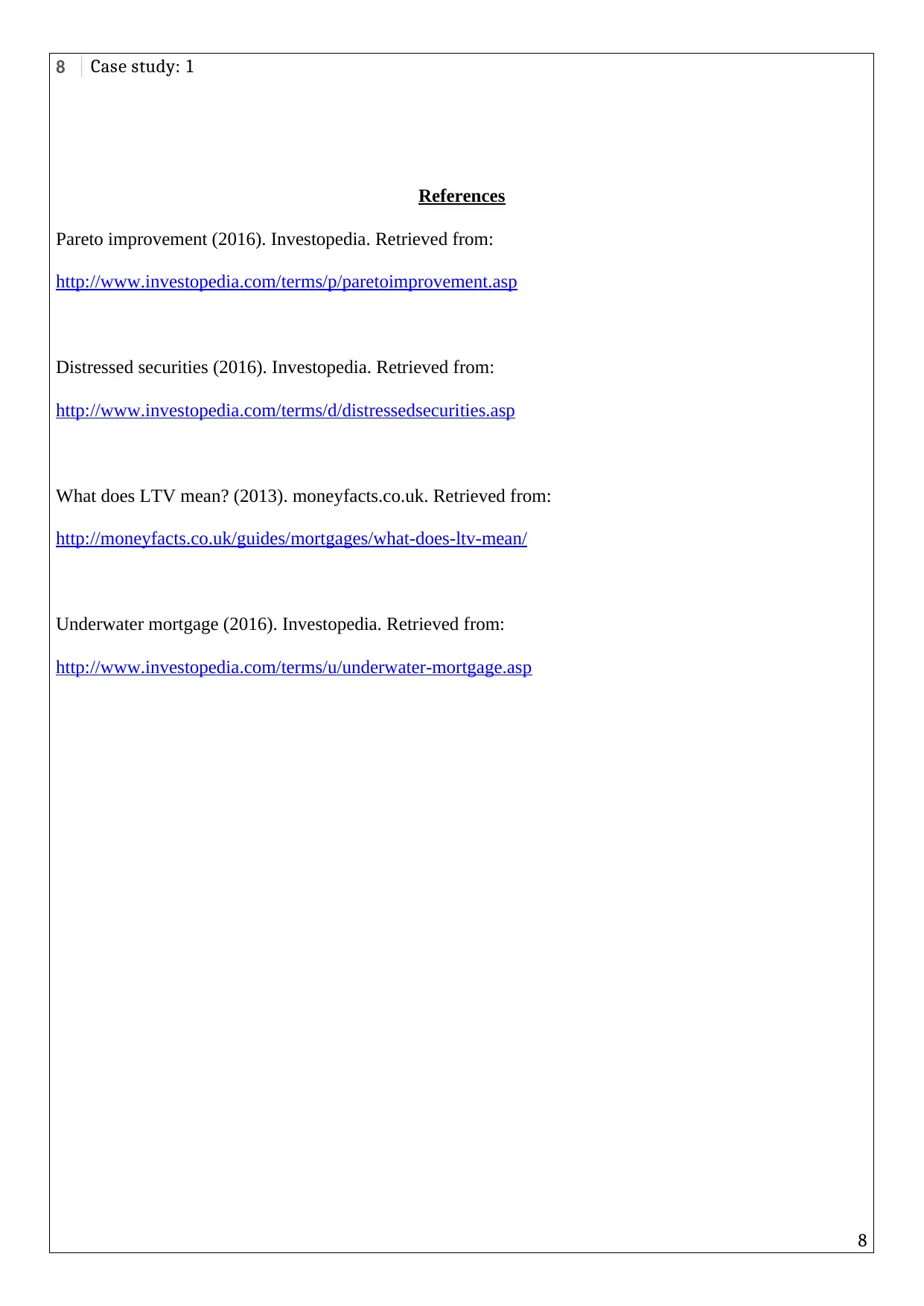
8 Case study: 1
References
Pareto improvement (2016). Investopedia. Retrieved from:
http://www.investopedia.com/terms/p/paretoimprovement.asp
Distressed securities (2016). Investopedia. Retrieved from:
http://www.investopedia.com/terms/d/distressedsecurities.asp
What does LTV mean? (2013). moneyfacts.co.uk. Retrieved from:
http://moneyfacts.co.uk/guides/mortgages/what-does-ltv-mean/
Underwater mortgage (2016). Investopedia. Retrieved from:
http://www.investopedia.com/terms/u/underwater-mortgage.asp
8
References
Pareto improvement (2016). Investopedia. Retrieved from:
http://www.investopedia.com/terms/p/paretoimprovement.asp
Distressed securities (2016). Investopedia. Retrieved from:
http://www.investopedia.com/terms/d/distressedsecurities.asp
What does LTV mean? (2013). moneyfacts.co.uk. Retrieved from:
http://moneyfacts.co.uk/guides/mortgages/what-does-ltv-mean/
Underwater mortgage (2016). Investopedia. Retrieved from:
http://www.investopedia.com/terms/u/underwater-mortgage.asp
8
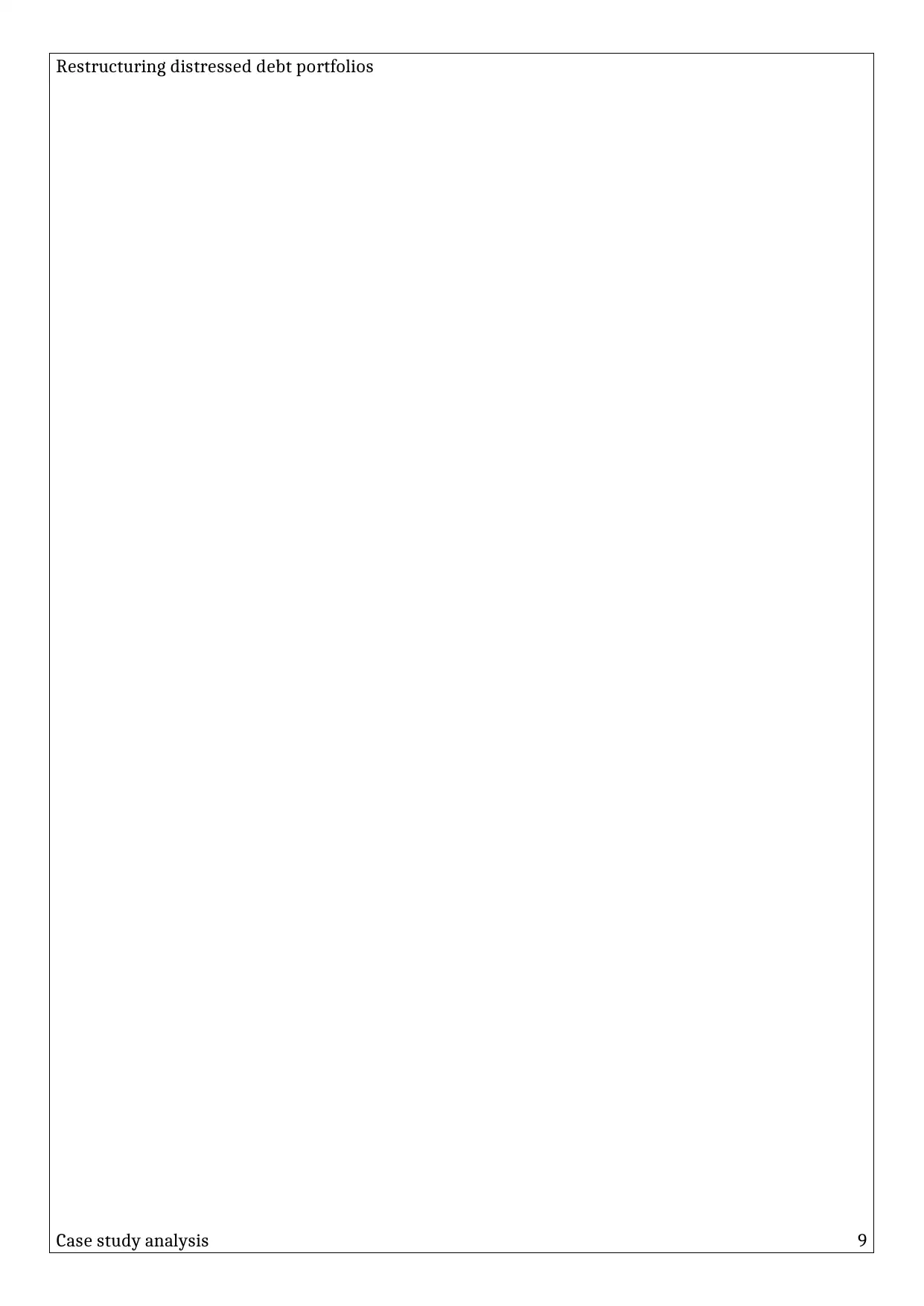
Restructuring distressed debt portfolios
Case study analysis 9
Case study analysis 9
⊘ This is a preview!⊘
Do you want full access?
Subscribe today to unlock all pages.

Trusted by 1+ million students worldwide
1 out of 9
Your All-in-One AI-Powered Toolkit for Academic Success.
+13062052269
info@desklib.com
Available 24*7 on WhatsApp / Email
![[object Object]](/_next/static/media/star-bottom.7253800d.svg)
Unlock your academic potential
Copyright © 2020–2025 A2Z Services. All Rights Reserved. Developed and managed by ZUCOL.


